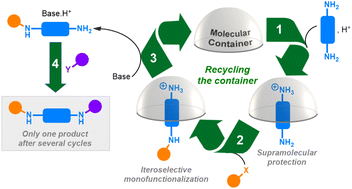Supramolecular protection with a recyclable molecular container: an efficient strategy for the one-pot selective functionalization of polyfunctional substrates†
Abstract
The control of the selective transformation of a functional group on a substrate bearing multiple identical reactive functions is a major synthetic challenge. The use of macrocyclic molecular containers as supramolecular protecting units is in this context a promising strategy. We report here on a hexahomotrioxacalix[3]arene molecular container whose exceptional binding properties opens new directions for the supramolecular protection strategy. This macrocyclic receptor binds primary ammonium ions with high selectivity and affinity, allowing for the monofunctionalization of diamines. The reaction was readily achieved with various diamines and different types of reagents. The acid–base control of the protection/deprotection of the substrate furthermore allowed for the recovery and recycling of the molecular container and the subsequent in situ accumulation of non-symmetric difunctionalized products, with remarkably no loss of selectivity over the reaction cycles. This recycling strategy considerably increases the synthetic viability of the supramolecular approach with only a catalytic amount of molecular container needed. The synthesis of products, such as non-symmetric diamino-diureas, which are difficult to obtain via classical synthetic routes, was also achieved through the one-pot reaction of mixtures of difunctional substrates monoprotected by the molecular container. The supramolecular protection strategy was finally extended to the selective functionalization of more complex polyamines such as a triamine and a lysine derivative. These results show that the use of a supramolecular protecting container for the functionalization of polyfunctional substrates presents many synthetic advantages over strategies using traditional protecting groups: (i) it enables high chemo-, regio- and iteroselectivities through a one-pot protection/functionalization/deprotection sequence, (ii) it avoids the introduction and removal of covalently linked protecting groups thus leading to high yield, (iii) it allows the formation of unstable intermediates and the control of their reactivity, (iv) it gives access to complex polyfunctional products whose synthesis remains challenging through classical synthetic methods.

- This article is part of the themed collection: 2023 Organic Chemistry Frontiers HOT articles


 Please wait while we load your content...
Please wait while we load your content...